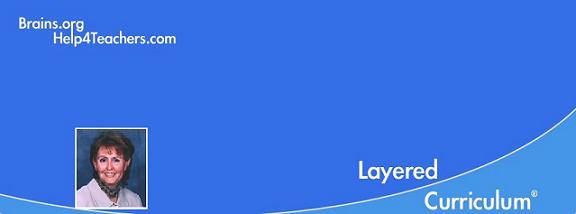__________Layered Curriculum®. . . because every child deserves a special education™_
 |
|
![]() _
_ ![]()
Layered
Curriculum TEXT & WORKBOOK
Set
for only
$43.95
(free shipping in
US)
Tweet
Teaching Digital Natives
© Dr Kathie Nunley, 2016First there were the baby boomers at the dawn of the television era, then came the X generation and the net generation as media became an ever bigger part of our lives. And now we have the digital natives, also known as the I-generation. This new i-generation spends more time consuming media than any prior generation - by a wide margin. Current studies show that today's young people spend as much as 20.5 hours every day on media consumption!
As amazing as that may seem, it also correlates with changes we see in the attention region of the brain - the Reticular Activating System (RAS). Located at the base of the brain, The RAS's job is to sort through all incoming information and decide what to attend to, what to ignore, and how to set attention priorities. It bases that decision on physical need, novelty and self-choice, in that order.
As a result of this increased exposure and use of electronic media, the RAS has changed over the past several decades. Attention spans are shorter, and the need for novelty has gotten greater. (Nunley, 2006). Students reports of boredom in school have risen. And that boredom has had negative effects on academic performance. (Pekrun, 2014).
The ability of young people today to switch attention between tasks in phenomenal. It comes at a cost however. Most young people now lose attentional focus every 3 minutes. And they are highly addicted to their personal electronic devices. In fact, 38% of children cannot go 10 minutes without checking their phones, tablets and other social media channels without a significant degree of anxiety (Rosen, 2011). Students identified with Attention Deficit Disorder are even more challenged with attention focus.
These changes are not new news for today's classroom teachers. Teachers of all grades have noticed with increasing frustration, how students have become more and more dependent on personal electronic devices. And teachers feel that they are losing (or have lost) the competitive battle for control of student attention.
Simply removing the boredom isn't the answer. Research tells us that it takes more than positive emotions for student success. Those emotions are mediated by self-regulated learning and motivation. (Mega, 2013). For real academic achievement, students need to feel in control of their learning, and be actively involved in their learning.
It's time to embrace these technological wonders as valuable teaching aids, and not threats to teacher security or ability to deliver instruction.
One of the easiest ways to do this is with learning systems which let you use these devices as part of the instructional process. Lessons which include the power of the smartphone, allow a safe and teacher-designed way to channel these devices into real learning opportunities. The novelty of being able to use these in a unique way plays right into the priorities of the brain and thus become a priority for student attention. Novelty in particular is attractive to the RAS. Both novelty and surprise engage students' attention, reduce boredom and strengthen learning. (Willis, 2008; Pekrun, 2014)
As you design student learning activities, look for ways to include options for utilizing their personal devices such as tablets and smartphones - both in the classroom and as homework. Twitter feeds, texting games, timed google searches, as well as cooperative in-depth investigations using handheld devices all help blend technology and engage today’s student.
It's the win-win everyone is looking for, and exactly what the brain is now waiting for.
About the Author:
Dr Kathie Nunley is an educational psychologist, researcher and author of several books on parenting and teaching, including A Student's Brain (Brains.org) and the best selling, "Differentiating the High School Classroom" (Corwin Press). She is the developer of the Layered Curriculum® method of instruction and has worked with parents and educators around the world to better structure schools to make brain-friendly environments. In addition, her work has been used by the Boeing Corporation, Family Circle Magazine, the Washington Post, and ABC television.
Email her: Kathie (at) brains.orgCitations
Mega, C. et al. (2013). "What Makes a Good Student? How Emotions, Self-Regulated Learning, and Motivation Contribute to Academic Achievement." Journal of Educational Psychology, July 1 preview.
Nunley, K. (2006). A Student's Brain: The parent / teacher manual. Amherst, NH:Brains.org
Pekrun, R. et al. (2014). "Boredom and academic achievement: Testing a model of reciprocal causation."Journal of Educational Psychology, Vol 106(3), 696-710.
Rosen, L. (2011). "Poke Me: how Social Networks can both Help and Harm out Kids" presented at the American Psychological Association National Convention.
Willis, J. (2008) How Your Child Learns Best: Brain-friendly strategies you can use to ignite your child's learning and increase school success. Naperville, IL: Sourcebooks
Copyright © 1998 - current year by Kathie F. Nunley.
All Rights Reserved.
Layered
Curriculum is a registered trademark developed by
Dr. Kathie F. Nunley.